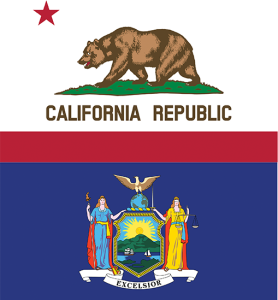 In 2020 and 2021, Special Purpose Acquisition Companies (SPACs) were all the rage. A SPAC is a “blank check company,” publicly traded, and organized for the purpose of merging with a private company. It’s a mechanism for a private operating company to go public without doing its own IPO. Though SPACs have existed for decades, their use skyrocketed in the last couple years. While insurers, brokers and attorneys have developed a level of expertise on risks and insurance coverage in connection with SPAC formation and completed de-SPAC transactions, the insurance implications of failed SPACs was not addressed in 2020 and 2021 and is still not fully understood or appreciated.
In 2020 and 2021, Special Purpose Acquisition Companies (SPACs) were all the rage. A SPAC is a “blank check company,” publicly traded, and organized for the purpose of merging with a private company. It’s a mechanism for a private operating company to go public without doing its own IPO. Though SPACs have existed for decades, their use skyrocketed in the last couple years. While insurers, brokers and attorneys have developed a level of expertise on risks and insurance coverage in connection with SPAC formation and completed de-SPAC transactions, the insurance implications of failed SPACs was not addressed in 2020 and 2021 and is still not fully understood or appreciated.
Articles Posted in D&O
California and New York to Open One-Year Windows Reviving Time-Barred Adult Sexual Assault Claims
 Four months ago, New York Governor Kathy Hochul signed the Adult Survivors Act (ASA) (S.66A/A.648A), creating a one-year window, beginning November 24, 2022, for adult survivors of sexual assault to bring civil claims against their alleged attackers which otherwise would have been time barred. On September 19, 2022, California Governor Gavin Newsom signed an equivalent law, the Sexual Abuse and Cover Up Accountability Act (AB-2777), which similarly suspends the statute of limitations for civil claims of sexual assault and other vicarious offenses arising out of that conduct starting January 1, 2023. These laws will likely generate a surge of litigation in California and New York, undoubtedly impacting many businesses operating there. Many, if not most, of those companies will look to insurers to furnish legal defenses and to financially support settlements or damage awards based on past policies.
Four months ago, New York Governor Kathy Hochul signed the Adult Survivors Act (ASA) (S.66A/A.648A), creating a one-year window, beginning November 24, 2022, for adult survivors of sexual assault to bring civil claims against their alleged attackers which otherwise would have been time barred. On September 19, 2022, California Governor Gavin Newsom signed an equivalent law, the Sexual Abuse and Cover Up Accountability Act (AB-2777), which similarly suspends the statute of limitations for civil claims of sexual assault and other vicarious offenses arising out of that conduct starting January 1, 2023. These laws will likely generate a surge of litigation in California and New York, undoubtedly impacting many businesses operating there. Many, if not most, of those companies will look to insurers to furnish legal defenses and to financially support settlements or damage awards based on past policies.
Strengthening Corporate Officer Protection: Delaware’s Updated Corporate Exculpation Law and Its Impact on D&O Liability Insurance
 As the preferred place of incorporation for most U.S. companies, Delaware has long been a leader in the development of statutory and common law on corporate governance. In keeping with this role, the Delaware legislature recently amended its corporate code to permit enhanced legal exculpation of officers of Delaware corporations. Let’s look at this amendment and its implications for D&O insurance.
As the preferred place of incorporation for most U.S. companies, Delaware has long been a leader in the development of statutory and common law on corporate governance. In keeping with this role, the Delaware legislature recently amended its corporate code to permit enhanced legal exculpation of officers of Delaware corporations. Let’s look at this amendment and its implications for D&O insurance.
Abortion as an Employee Health Benefit – How to Protect against Potential Liability Post-Dobbs
 Amazon. Bank of America. Citigroup. Dick’s Sporting Goods. JP Morgan. Kroger. Meta. Microsoft. Procter & Gamble. Target. Walt Disney Company. These are just a few of what is a growing list of companies that have offered to cover costs for employees who may now need to travel out of state to receive abortion care in light of the Supreme Court’s decision in Dobbs v. Jackson Women’s Health Organization. But companies that are stepping up to further protect their employees’ reproductive rights are choosing to do so in the face of potential public backlash and uncertain legal risks.
Amazon. Bank of America. Citigroup. Dick’s Sporting Goods. JP Morgan. Kroger. Meta. Microsoft. Procter & Gamble. Target. Walt Disney Company. These are just a few of what is a growing list of companies that have offered to cover costs for employees who may now need to travel out of state to receive abortion care in light of the Supreme Court’s decision in Dobbs v. Jackson Women’s Health Organization. But companies that are stepping up to further protect their employees’ reproductive rights are choosing to do so in the face of potential public backlash and uncertain legal risks.
Under the Right Circumstances: Some Considerations for Submitting a Notice of Circumstances
 An oft-repeated maxim in self-help literature is: “Do not let your circumstances define who you are.” In a similar vein, policyholders should proactively manage situations in which known circumstances may potentially give rise to an eventual claim.
An oft-repeated maxim in self-help literature is: “Do not let your circumstances define who you are.” In a similar vein, policyholders should proactively manage situations in which known circumstances may potentially give rise to an eventual claim.
Suppose a company perceives the potential risk of litigation or a government investigation. This may not necessarily be the result of any known wrongful conduct—such risk may just be inherent in the company’s business model or within the company’s industry. When the company’s D&O insurance policy (or employment liability or professional liability, as the case may be) is on the verge of expiring, the company may be faced with the decision whether to report such circumstances to the insurer under the policy’s “notice of circumstances” (NOC) provision, which permits the policyholder to provide notice of facts or events that may give rise to claims in the future. If such notice is given within the specified time, the insurer will treat any subsequent claims arising out of the noticed circumstances as claims first made within the policy period, even if the claims are brought much later.
SXSW Seeks Resolution of Federal’s Duty to Defend Underlying Ticketholder Class Action Arising from COVID-19 Cancellation
The widespread denial of coverage under first-party property insurance policies for business interruption losses resulting from the COVID-19 pandemic has been extensively reported, but so far less attention has been paid to related third-party claims and attendant coverage issues arising under liability insurance policies. When ticketed attendees sued the organizer of the South by Southwest (SXSW) music and film festival, SXSW LLC, for refunds after the 2020 annual event was cancelled because of the COVID-19 pandemic, the company’s liability insurer, Federal Insurance Company, refused to make good its duty to defend. SXSW has now sued Federal in the U.S. District Court for the Western District of Texas seeking a declaration that Federal owes a duty to defend SXSW against the underlying putative class action, providing insight on COVID-19-related liability coverage issues.
Insurability Update: New York High Court Affirms Coverage for Settlement Amount Labeled “Disgorgement”
 Last month, we discussed a decision by the Northern District of Illinois finding an amount labeled “restitution” in a settlement between a pharmaceutical company and the DOJ was insurable loss under a D&O policy. Shortly after that post, the New York Court of Appeals reached a similar conclusion, continuing the trend of looking beyond the labels used for the payments in the underlying settlement agreement. In rejecting the insurers’ argument, the court evaluated the purpose of the payments and the nature of how they were derived to find the payments at issue were insurable under a Professional Liability policy, despite being called “disgorgement.”
Last month, we discussed a decision by the Northern District of Illinois finding an amount labeled “restitution” in a settlement between a pharmaceutical company and the DOJ was insurable loss under a D&O policy. Shortly after that post, the New York Court of Appeals reached a similar conclusion, continuing the trend of looking beyond the labels used for the payments in the underlying settlement agreement. In rejecting the insurers’ argument, the court evaluated the purpose of the payments and the nature of how they were derived to find the payments at issue were insurable under a Professional Liability policy, despite being called “disgorgement.”
In Another Blow to the “Uninsurability” Defense, Court Holds that Settlement Labeled “Restitution” Is Insurable
 In previous posts, we have emphasized the continued judicial trend rejecting insurer arguments that losses purportedly sounding in restitution or disgorgement are “uninsurable” under D&O policies. Despite that trend, insurers continue to invoke “uninsurability” under state law or vague notions of public policy, even where such a doctrine has not been recognized in the relevant jurisdiction.
In previous posts, we have emphasized the continued judicial trend rejecting insurer arguments that losses purportedly sounding in restitution or disgorgement are “uninsurable” under D&O policies. Despite that trend, insurers continue to invoke “uninsurability” under state law or vague notions of public policy, even where such a doctrine has not been recognized in the relevant jurisdiction.
Follow the Leader: How Ambiguities in Excess Follow-Form Policies Can Lead Policyholders Down a Crooked Path
 A feature of most corporate liability insurance programs is the tower system of coverage: a primary policy with several overlying excess policies stacked atop one another collectively providing coverage up to a desired (or available) limit of liability. Depending on the size and liability exposures of a policyholder, a tower can consist of dozens of policies providing limits totaling hundreds of millions of dollars. Adding to this complexity, excess policies often share layers of coverage in quota share arrangements, sometimes subscribing to the same policy but more often issuing separate policies for a stated percentage of the quota share whole. To avoid as much as possible an impenetrable web of conflicting coverage terms, excess policies often “follow form” to the underlying coverage (usually to the primary policy) providing the insurer certainty and providing the policyholder a consistent tower of coverage. It is not always possible, though, to obtain clarity and certainty in tower placements. Insurance companies issuing excess coverage may not wish to agree to all the terms included in the underlying policies, and so may offer additional or differing terms, creating inconsistencies in an otherwise monolithic tower. For example, a primary insurer may refuse to cover punitive damages whereas an excess insurer may agree to do so, or vice versa.
A feature of most corporate liability insurance programs is the tower system of coverage: a primary policy with several overlying excess policies stacked atop one another collectively providing coverage up to a desired (or available) limit of liability. Depending on the size and liability exposures of a policyholder, a tower can consist of dozens of policies providing limits totaling hundreds of millions of dollars. Adding to this complexity, excess policies often share layers of coverage in quota share arrangements, sometimes subscribing to the same policy but more often issuing separate policies for a stated percentage of the quota share whole. To avoid as much as possible an impenetrable web of conflicting coverage terms, excess policies often “follow form” to the underlying coverage (usually to the primary policy) providing the insurer certainty and providing the policyholder a consistent tower of coverage. It is not always possible, though, to obtain clarity and certainty in tower placements. Insurance companies issuing excess coverage may not wish to agree to all the terms included in the underlying policies, and so may offer additional or differing terms, creating inconsistencies in an otherwise monolithic tower. For example, a primary insurer may refuse to cover punitive damages whereas an excess insurer may agree to do so, or vice versa.
Navigating the Tightening D&O Insurance Market for SPACs

In the finance world, Special Purpose Acquisition Companies (SPACs) are proliferating like Dutch tulips. This year alone, they’ve exploded in popularity, with multitudes of celebrities, politicians, and influencers sponsoring SPACs of their own. The list includes the likes of Colin Kaepernick, Shaquille O’Neal, Alex Rodriguez and Tony Hawk. Even amidst new concerns from the SEC, which reportedly opened an inquiry into the investment risks of SPACs and issued a bulletin warning prospective investors to exercise caution investing in celebrity-sponsored SPACs, SPACs have raised staggering amounts of capital.
 Policyholder Pulse
Policyholder Pulse


